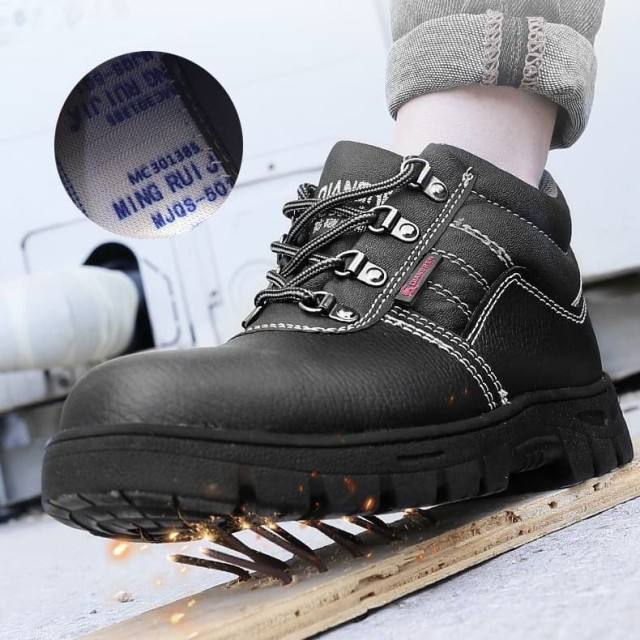When workplace safety is on the line, meeting OSHA’s minimum requirements is just the starting point. Employers need safety footwear that actively prevents injuries by addressing specific hazards—from electrical risks to heavy falling objects. This guide reveals how to select protective footwear that goes beyond compliance, leveraging industry standards like ASTM and ISO to create safer, more cost-effective workplaces.
Understanding OSHA’s Role in Safety Footwear
OSHA’s Minimum Requirements and Their Limitations
OSHA mandates that safety footwear must protect against common workplace hazards, such as impact and compression. However, these standards represent a baseline—not an optimal level of protection. For example:
- Impact resistance under OSHA may not account for extreme weights in industries like construction or mining.
- Electrical hazard protection is often limited to basic insulation, leaving workers vulnerable in high-voltage environments.
Research shows that workplaces using footwear meeting only OSHA minima experience higher injury rates compared to those adopting stricter certifications.
Key Hazards Requiring Protective Footwear
Beyond OSHA’s scope, these hazards demand specialized features:
- Puncture risks: Sharp objects (e.g., nails in construction) require midsoles rated for puncture resistance.
- Static electricity: In chemical plants, conductive footwear prevents sparks that could ignite flammable vapors.
- Slips and falls: Oil-resistant outsoles (tested under ASTM F2913) reduce accidents in food processing or automotive settings.
Selecting Safety Footwear Beyond OSHA Standards
Industry Standards to Prioritize (ASTM, ANSI, ISO)
Upgrading to these certifications ensures superior protection:
- ASTM F2413: Covers impact/compression (e.g., toes withstand forces exceeding 200 joules) and metatarsal guards.
- EN ISO 20345: Adds slip resistance and energy absorption for European markets, often exceeding ASTM durability tests.
- ANSI Z41: While phased out, its legacy informs current ASTM criteria for electrical hazard ratings.
Matching Footwear Features to Hazard Types
Tailor footwear to your workplace’s unique risks:
| Hazard Type | Recommended Feature | Certification to Seek |
|---|---|---|
| Falling objects | Steel/composite toe caps | ASTM F2413-18 (I/75) |
| Electrical exposure | EH-rated (non-conductive) soles | ASTM F2413-11 (EH) |
| Chemical spills | Acid-resistant rubber uppers | ISO 20345:2022 (WR) |
For environments with multiple risks, composite materials (e.g., fiberglass toes) offer lightweight, all-hazard protection.
Proven Benefits of Exceeding OSHA Standards
Case Studies: Reduced Injuries and Costs
A 3-year study of manufacturing plants found that switching to ASTM-compliant footwear led to:
- ~30% fewer foot injuries from heavy machinery.
- Lower workers’ compensation claims, with one auto parts supplier saving over $200,000 annually.
Long-Term ROI of High-Quality Safety Footwear
While premium safety boots cost 20–40% more upfront, their extended lifespan (often 2–3x longer than basic models) and injury prevention deliver measurable returns:
- Fewer replacements: Heat-resistant outsoles (tested to 300°C) degrade slower in foundries.
- Higher productivity: Ergonomically designed footwear reduces fatigue during 12-hour shifts.
Upgrade Your Workplace Safety with 3515
As a trusted manufacturer for distributors and bulk buyers, 3515 designs safety footwear that combines OSHA compliance with advanced hazard protection. Our ASTM and ISO-certified boots are engineered for real-world risks—ensuring your team stays safe while you control costs. [Contact 3515] to explore custom solutions tailored to your industry’s challenges.
Related Products
- Wholesale Customizable Suede Safety Boots - Puncture-Proof with Velcro Closure
- Puncture-Resistant Velcro Safety Boots for Wholesale & Custom Manufacturing
- Durable Leather Moc Toe Work Boots for Wholesale & Custom Manufacturing
- Durable Moc-Toe Wedge Work Boots | Wholesale Manufacturing for Brands
- Athletic Safety Shoes with Dial Closure & Steel Toe for Wholesale & Custom Manufacturing
Related Articles
- How to Extend Work Boot Lifespan: Science-Backed Care for Safety & Savings
- How to Choose Work Boots That Match Your Job Demands and Safety Needs
- Matching Men’s Work Shoe Safety Technologies to Workplace Hazards
- How to Choose Work Boots That Match Your Job's Safety Demands
- How to Choose Work Boots That Balance Safety, Comfort, and Durability for Your Job



















